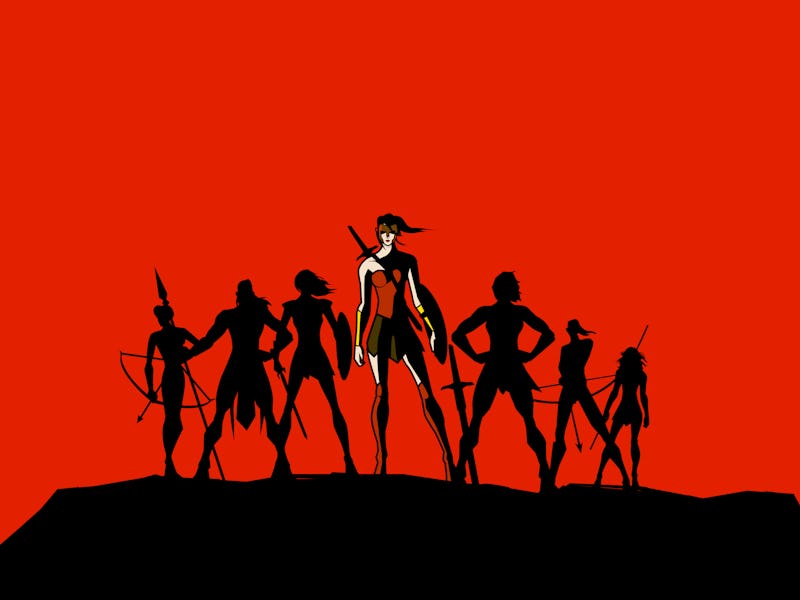Four actual Wonder Women discovered in ancient tombs in Russia
Scientists just upstaged DC's June blockbuster with the real thing.

The latest Wonder Woman movie isn’t set to drop until June 2020, but scientists just upstaged DC’s production efforts. The remains of four real-life female warriors spanning three different generations have been unearthed in Russia.
Working at an ancient burial site in Russia’s Ostrogozhsky Voronezh region, a team of scientists uncovered the burial sites of four Scythian warrior women. The remains include those of a woman in her late forties, two women in their twenties, and one as young as 12 or 13 years old. The burial likely occurred during fourth century BCE, scientists say.
This is the first time that three different generations of warrior women were found together. Speaking to the Washington Post, Adrienne Mayor, historian of ancient science at Stanford University, said the diversity of ages suggests that Scythian women and girls went into battle.
The remains of the eldest Scythian warrior woman found during the expedition, complete with her headdress.
“The fact that you have a range of ages is important because people previously thought that mothers wouldn’t be out fighting because they had children,” Mayor said.
The women were found surrounded by jewelry, pottery, a rather unique headdress, and enough weaponry to convince the scientists that these women really were fighters — the very kind that inspire the Wonder Woman movies and comics.
The real life wonder women
The Scythians were a group of nomadic warriors who lived in Central Asia, and Eastern Europe between 900 and 200 BCE. Most of what we know about them comes from narratives handed down by the ancient Greeks, like Herodotus, who wrote that “None who attacks them can escape, and none can catch them if they desire not to be found.”
Two of the Scythian warrior women unearthed in Russia. One woman was found in the "horsemen" burial position -- intended to make it look like she was on horseback well beyond death.
One of the most enduring pieces of Scythian lore is that Scythian women were just as fierce fighters as their men. These female warriors may have inspired the mythological “Amazons” described Homer’s Iliad, and depicted in Classical Greek art.
Amazon women depicted in 1620 by Claude Deruet.
But according to some historians, these warrior women weren’t merely a fantasy drawn up by the ancient Greeks.
This isn’t the first time archaeological evidence has suggested that Amazon-like female warriors existed. In 2017, scientists unearthed the remains of a woman who lived more than 2,500 years ago in ancient Armenia. She sported battle wounds, suggesting that some cultures did have women fighters. In the same year, the remains of a viking woman hinted at the existence of so-called “shield maidens” — though that conclusion, some argued at the time, was premature.
The “landmark” discovery of these four women may help set the record straight.
Well-armed graves for well-armed women
Unlike previous finds, two of their gravesites were in particularly good condition, Valerii Guliaev, the archaeological expedition’s leader, said in a statement.
The eldest woman, wearing her headdress.
Two of the graves have been robbed in the thousands of years since these women died. But the other two graves are “well preserved” enough to provide unprecedented insight into these women’s lives.
The eldest woman was buried wearing a headdress decorated with floral patterns that wouldn’t be out of place in a Wonder Woman movie. That would have conferred status, though this is the first time it’s ever been found in an “Amazon” grave, Guliaev said. This woman was also buried alongside an iron knife.
A portion of the ceremonial headdress unearthed alongside the eldest Scythian woman.
One of the younger women was found in a pose called “the horsemen” — which means that several tendons in her knees were cut posthumously to make her prostrate body appear as if on horseback. She was buried alongside a bronze mirror, two spears, a bracelet made of glass beads, a small dish and a cup used for drinking wine.
The graves were filled with a decent amount of weaponry, consisting of thirty iron arrowheads, fragments of a horse harness, numerous iron knives, animals’ bones, and an iron hook shaped like a bird. The findings suggest that these Scythian women were afforded the same burial rites of their male counterparts, Guliaev said.
“All burial rites which were usually made for men were done for them,” he said.
They may not look much like Gal Gadot. But going by their tombs, they were definitely just as bad ass.